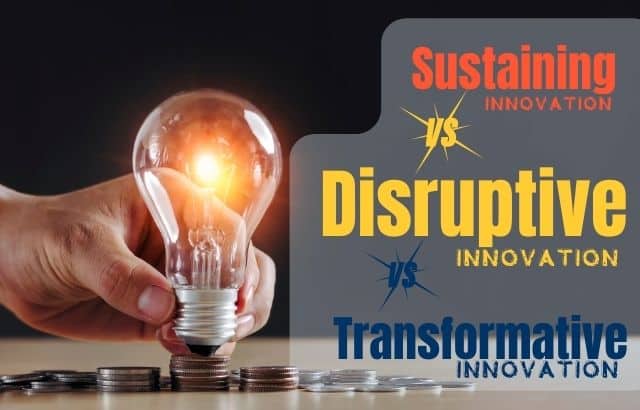In the fast-paced world of technology and business, staying ahead of the competition often hinges on a company’s ability to innovate. But innovation isn’t a one-size-fits-all concept. To truly excel, businesses must understand and strategically apply three key types of innovation: sustaining, disruptive, and transformative. Each type plays a unique role in shaping market dynamics and driving long-term success.
Table of Contents
TechCo: A Case Study in Innovation and Adaptation
Once upon a time, there was a company named TechCo, renowned for its high-quality desktop computers. With over a decade in the industry, TechCo had established itself as a leading computer manufacturer.
As market dynamics began shifting, with customers increasingly leaning towards laptops and mobile devices, TechCo’s CEO recognized the need for innovation to maintain their competitive edge.
TechCo embraced three distinct types of innovation: sustaining, disruptive, and transformative.
For sustaining innovation, TechCo focused on enhancing their desktop computers through incremental improvements. They introduced faster processors and superior graphics, which helped them retain their loyal customer base.
In the realm of disruptive innovation, TechCo launched a new series of laptops that were both more affordable and lightweight compared to previous models. This move enabled them to tap into a new market segment, attracting customers seeking portable and budget-friendly options.
For transformative innovation, TechCo heavily invested in research and development to create groundbreaking augmented reality devices. These devices promised to revolutionize user interaction with technology, offering a more immersive and intuitive experience with digital content.
Through these strategic innovations, TechCo successfully navigated market changes, staying ahead of the competition and securing its position as a leader in the tech industry. By addressing evolving customer needs with diverse innovation strategies, TechCo ensured its continued relevance and success in a dynamic market.
Sustaining, Disruptive, and Transformative Innovation: What’s the Difference?
Types of Innovation- Sustaining innovation

refers to incremental improvements made to existing products, services, or processes to maintain their competitiveness in the market. This type of innovation aims to improve the performance, features, or user experience of existing products, without fundamentally changing the way they work or the markets they serve. Sustaining innovation usually targets existing customers and aims to retain their loyalty while attracting new customers.
Types of Innovation- Sustaining innovation examples

refers to the incremental improvements made to existing products, services, or processes in order to maintain their competitiveness in the market. Here are some examples of sustaining innovations:
- Apple releasing updated versions of the iPhone with better features and performance every year.
- Automakers introducing new models of cars with improved fuel efficiency, safety features, and technology.
- Food and beverage companies releasing new flavors or variations of existing products to appeal to changing consumer preferences.
- Banks and financial institutions introducing new digital banking features to improve the customer experience.
- Pharmaceutical companies developing improved versions of existing drugs with fewer side effects or more targeted treatment options.
- Software companies releasing updated versions of their products with bug fixes and new features.
- Consumer electronics companies releasing updated versions of products with improved battery life and performance.
- Retailers introducing new store layouts or product displays to enhance the shopping experience.
- Social media platforms adding new features and tools to improve user engagement.
- Healthcare providers introducing new medical devices or equipment to improve patient outcomes.
Types of Innovation- Disruptive innovation

refers to the introduction of new products, services, or processes that disrupt the existing market and create a new market. This type of innovation often starts by serving overlooked or underserved customers, with a product or service that is initially inferior to existing offerings. However, disruptive innovations gradually improve their performance and features, and eventually overtake existing products and services in the market. Disruptive innovation typically creates new markets and may even render existing markets obsolete.
Disruptive innovation examples

refers to the introduction of new products, services, or processes that disrupt the existing market and create a new market. Here are some examples of disruptive innovations:
- Uber and other ride-hailing services disrupted the taxi industry by providing an on-demand, app-based transportation service.
- Airbnb disrupted the hospitality industry by offering a platform for individuals to rent out their homes and properties to travelers.
- Netflix disrupted the entertainment industry by introducing a streaming service that allowed viewers to watch movies and TV shows on-demand, without the need for cable TV.
- Tesla disrupted the automobile industry by introducing electric cars with longer ranges, innovative technology, and sleek designs.
- Amazon disrupted the retail industry by offering a vast selection of products online, along with fast and convenient delivery options.
- Skype disrupted the telecommunications industry by offering free or low-cost internet-based voice and video calls.
- 3D printing disrupted the manufacturing industry by offering a new way to produce prototypes, parts, and even entire products.
- Online education disrupted the traditional education system by offering more affordable and accessible learning opportunities to students around the world.
- Social media disrupted the advertising industry by offering a new way for brands to connect with customers and promote their products and services.
- Mobile banking disrupted the financial industry by offering convenient, on-the-go access to banking services and transactions.
Transformative innovation

refers to the introduction of new products, services, or processes that fundamentally change the way society operates and interacts. This type of innovation aims to solve complex societal challenges, create new opportunities, and transform entire industries and markets. Transformative innovations are often driven by breakthrough technologies, and they may require significant changes in the way people think, work, and live. Transformative innovation has the potential to create entirely new industries, change the nature of work, and transform the way society functions.
In summary, sustaining innovation focuses on improving existing products, while disruptive innovation creates new markets and transforms existing ones. Transformative innovation aims to solve complex societal challenges and create new opportunities, often by introducing breakthrough technologies.
Transformative innovation examples

refers to the introduction of new products, services, or processes that fundamentally change the way society operates and interacts. Here are some examples of transformative innovations:
- The Internet and the World Wide Web have transformed the way people communicate, access information, and do business.
- The smartphone has transformed the way people communicate, access information, and interact with technology.
- Renewable energy sources like solar and wind power have the potential to transform the way the world generates and uses energy.
- Self-driving cars have the potential to transform transportation by reducing accidents, congestion, and emissions.
- CRISPR gene editing technology has the potential to transform healthcare by allowing scientists to edit genes and cure genetic diseases.
- Artificial intelligence and machine learning have the potential to transform industries ranging from finance to healthcare by automating tasks, improving decision-making, and creating new business opportunities.
- Blockchain technology has the potential to transform industries ranging from finance to supply chain management by creating secure, transparent, and decentralized systems.
- Virtual and augmented reality have the potential to transform industries ranging from entertainment to education by creating immersive and interactive experiences.
- Quantum computing has the potential to transform industries ranging from finance to drug discovery by solving problems that are beyond the capabilities of traditional computers.
- Space exploration and colonization have the potential to transform the way humans live, work, and interact with the universe.
Types of Innovation| FAQs by Hirav Shah

What is sustaining innovation?
Answer: Sustaining innovation involves incremental improvements to existing products or services, aiming to enhance performance and maintain customer satisfaction.
How does disruptive innovation differ from sustaining innovation?
Answer: Disruptive innovation introduces new products or services that significantly alter the market by creating new customer segments, often at lower prices or with new functionalities.
What is transformative innovation?
Answer: Transformative innovation refers to groundbreaking advancements that fundamentally change industries or create entirely new markets through revolutionary technologies or approaches.
Why is it important for companies to focus on all three types of innovation?
Answer: Focusing on sustaining, disruptive, and transformative innovations allows companies to address current market needs, adapt to new trends, and pioneer future advancements, ensuring long-term relevance and success.
Why All Three Matter
To thrive in a competitive environment, companies need to embrace all three types of innovation. Sustaining innovation helps businesses maintain their current market position, ensuring that existing products or services remain competitive. Disruptive innovation opens up new market opportunities and challenges established players, driving growth and expansion. Transformative innovation can propel a company to the forefront of industry evolution, positioning it as a leader in new technologies or business models.
By strategically balancing these types of innovation, companies can not only respond to current market trends but also anticipate future changes, ensuring their long-term success and relevance. Whether through incremental improvements, disruptive new entries, or revolutionary advancements, understanding and leveraging these innovation types is key to thriving in today’s dynamic business landscape.










